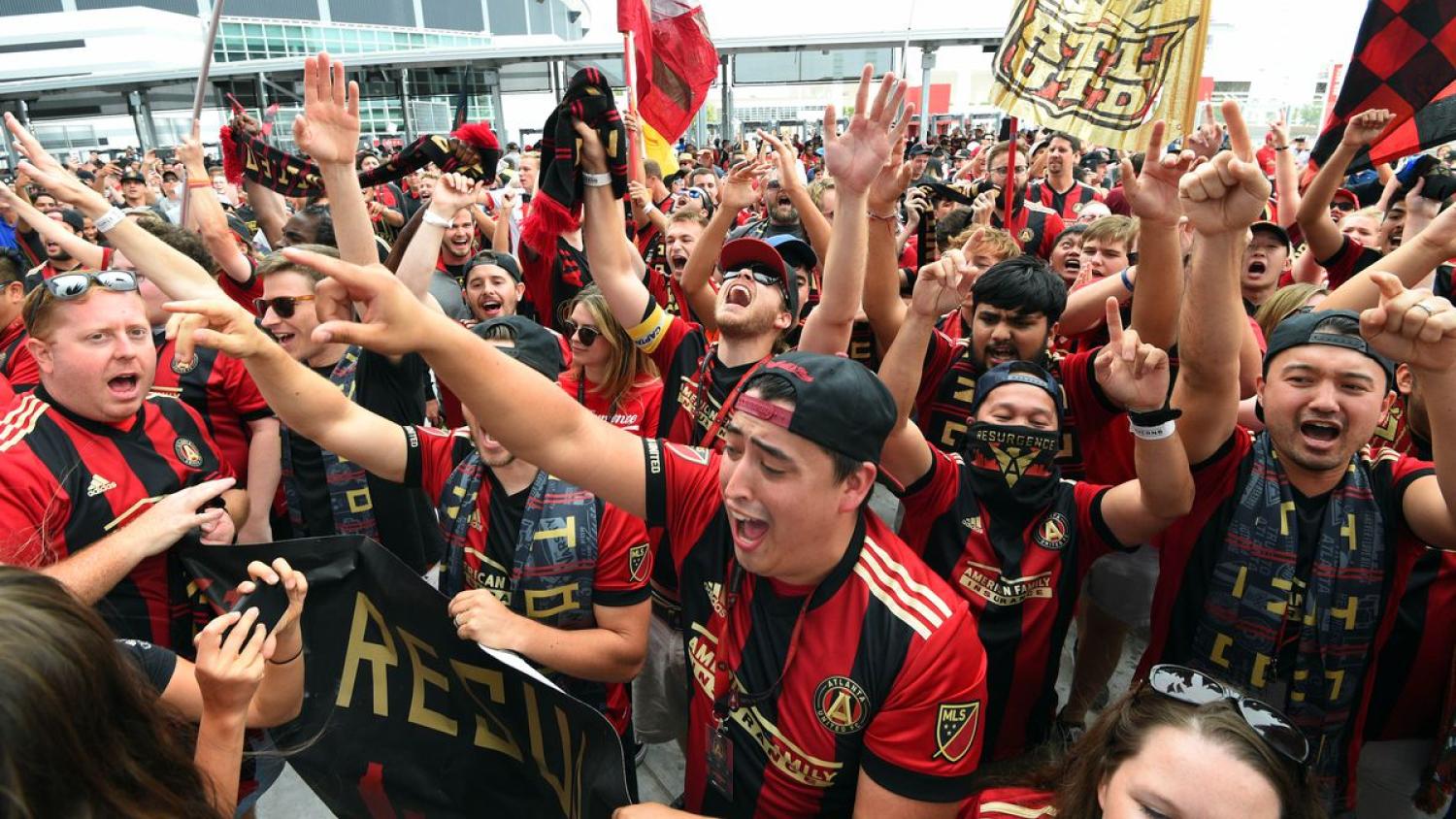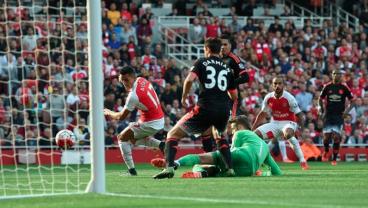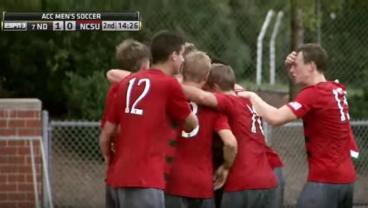Figuring out who has the best MLS team is fairly simple. There’s a long season followed by playoffs to determine the answer. But who has the best MLS fans? We’re here to tell you, definitively. And we know you’re unquestionably going to agree with every choice.
There may be other fan base rankings out there for MLS, but ours will be the best. Why? Because we said so. Some other organizations in the past have copped out and opted for a tie for first place, but we here at The18 actually respect you and give you what you want: a definitive ranking of the best MLS fan bases. Because a tie is like kissing your sister.
So without further ado, here is the ranking of best MLS fans from bottom to top.

Let us paint you a picture of the best MLS fans. Photo: @OliverUschmann | Twitter
No. 22 — D.C. United
Until D.C. United moves out of RFK Stadium, the poor fans in the nation’s capital will be stuck near the bottom of any ranking of MLS fan bases. Audi Field will open in 2018 and D.C. United will probably shoot up these rankings at that time.
For now, playing in the cavernous RFK Stadium, with a capacity north of 45,000, the paltry 16,400 that show up on average each week fail to create any sort of atmosphere. To be fair, the teams haven’t given the fans much to cheer about lately. Hopefully one of the league’s most proud franchises can turn things around.
No. 21 — FC Dallas
FC Dallas typically has some pretty good teams on display. Their current squad has a number of promising young talents that at one point looked ready to win the Supporter’s Shield. While they’ve fallen well off the pace in the second half of the season (a double-digit winless streak will do that), the fans consistently haven’t shown up. Dallas fans are probably too busy jumping on and off the Rangers or Mavericks bandwagons.
Part of that could be due to the fact the stadium is way too far north for most Dallas residents (it’s in the suburb of Frisco). It doesn’t help that there is absolutely no shade available for fans at Toyota Stadium. Turns out, summer in Texas is kinda hot. Who knew?
No. 20 — Columbus Crew
One of the original MLS clubs (often considered the first), Columbus just isn’t the same kind of draw as it once was. Only FC Dallas draws fewer fans on an average game day, with around 5,000 empty seats on any given day. Mapfre Stadium, which holds just under 20,000 fans, was the first soccer-specific stadium in the U.S., but the new-stadium smell has long since worn off (aided by the scoreboard catching on fire before a match).
The product on the field hasn’t been too bad since winning the Cup in 2008, but this year’s average attendance is on pace to be the lowest since 2012. Meanwhile, FC Cincinnati is the state’s best-drawing soccer team, averaging more than 21,000 despite playing in the USL. (To be fair, FCC’s 2017 attendance is better than all but seven MLS clubs.)
No. 19 — Chicago Fire
Toyota Park is a great stadium to watch a soccer match, the problem is the location. Chicago is a wonderful city, but the Chicago Fire don’t play in Chicago, they play in Bridgeview, 15 miles from downtown Chicago. Failed suburb experiments in Chicago and Dallas (among others) have proven to MLS the need to build stadiums closer to population centers.
It doesn’t help the team hasn’t won the MLS Cup since doing the double in the club’s first season back in 1998. The Fire finished 20th in MLS in 2015 and 2016 and despite an improved squad in 2017 (and Schweini!) the team still sits near the bottom of the league in attendance, which is unacceptable for a city of Chicago’s size.
No. 18 — Colorado Rapids
Oh look, another club with a poorly located stadium. The Rapids’ Dick’s Sporting Goods Park is pretty much in the middle of nowhere and thus the 18,000-seat stadium is rarely filled to capacity, trailing only Columbus and FC Dallas in average attendance in 2017.
Not that the Rapids have given fans too much to cheer about over the years. Despite being one of the initial 10 MLS teams, Colorado has never won its conference and only once finished better than third, though it did win the MLS Cup in 2010 after finishing fifth in the West. In its 21 seasons, only seven have finished with a winning record. But what would you expect from a team owned by the same man who owns Arsenal?
No. 17 — Philadelphia Union
Philadelphia is home to this third smallest soccer-specific stadium in MLS and Union fans still can’t fill it on a regular basis, despite a cool river-front location. (San Jose and Sporting KC are smaller but both average higher attendance.)
The club itself doesn’t have much history of success, never finishing better than eighth in the final league table and only reaching the playoffs twice in seven seasons. The Sons of Ben have lost a bit of steam since the club followed them into Philly and the fans could really use some quality teams to root for.
No. 16 — New England
We’ve established playing in the suburbs is a bad idea and D.C. United proves NFL stadiums are not the best way to create an MLS atmosphere. The poor New England Revolution combine the two by playing at Gillette Stadium. The Patriots’ venue isn’t a horrible stadium and the Revs fans get close (18,000 average in 2017) to filling the 20,000 seats open for soccer matches, but that doesn’t get rid of the 48,000 empty seats.
Supporters in The Fort and the Midnight Riders (who were named before the club) do their best to create a positive atmosphere for the New England team, but again, those tens of thousands of empty seats are an eye sore.
No. 15 — New York Red Bulls
The Red Bulls have one of the biggest, nicest soccer-specific stadiums to call home, but in 2017 fans are leaving on average nearly 5,000 seats empty in the 25,000-seat venue. Yes, the stadium is technically in New Jersey, but given the massive amount of people living in the surrounding area, you’d expect better.
Dating back to its days as the MetroStars, the club that has plenty of history and is almost always competitive, making the playoffs every year since 2002. Shockingly, the club hasn’t averaged more than 21,000 fans per match since its inaugural season in 1996.
No. 14 — Houston Dynamo
BBVA Compass Stadium is a shockingly orange arena in a good location in a city passionate about soccer, but the Dynamo struggle to fill the brightly colored seats on the regular. In 2017, despite flirting with the top of the league standings, Houston is averaging 17,600 fans in the 22,000-seat venue, which is too low for the fourth-largest city in the U.S.
Part of the problem is, even with a partial roof, it’s hot and immensely humid during the summer. The fans that do show up can create an amazing atmosphere under the right conditions. But the Dynamo haven’t quite caught the imagination of fans since back-to-back championships in their first two years in Houston.
No. 13 — L.A. Galaxy
StubHub Center is the largest soccer-specific stadium in the U.S. and was one of the first, opened in 2003. But despite being just outside in the second-largest city in the country, only 21,844 fans file into the 27,000-seat stadium on an average match day.
Much of this is due to the fact the Galaxy’s star power has changed dramatically — Landon Donovan, David Beckham and Robbie Keane have been replaced by Gyasi Zardes, Jermaine Jones and the Dos Santos brothers — and the fact L.A. is one of the worst teams in the league in 2017. With LAFC set to land soon, the Galaxy risk losing the city.
No. 12 — New York FC
New York FC ranks fifth in attendance in 2017 while playing at Yankee Stadium in the Bronx, but regularly leaves on average 3,000 seats empty despite playing in the country’s largest city. But the club could really benefit from playing in a stadium that’s actually suited for soccer.
The club has plenty of catching up to do with New York Red Bulls, who had a nearly two-decade head start, but if NYCFC can learn anything from the Yankees, it’s that winning will garner you plenty of fans regardless of how you go about your business.
No. 11 — San Jose Earthquakes
San Jose is in an odd situation considering the fans lost their club to Houston in 2006 only to receive a new team in 2008. Earthquakes fans won’t take their club for granted, even if they weren’t the reason the team left in the first place.
Now in Avaya Stadium, San Jose regularly sells out to create a good atmosphere despite having missed the playoffs from 2013-16. Rancid guitarist and singer Lars Frederiksen wrote the team’s “Never Say Die” anthem, surprisingly not the only Rancid-written anthem mentioned on this list. But San Jose out-punks Salt Lake City any day.
No. 10 — Montreal Impact
The Impact may be the forgotten Canadian team in MLS, but their fans regularly sell out Saputo Stadium, a 20,801-seat soccer-specific venue near Montreal’s Olympic Stadium, which Impact fans have on occasion filled up.
The club, which started in MLS in 2012, lacks a lot of history (and success), but in a large metropolitan area with only an NHL team to compete with, Montreal fans show plenty of love for their football team.
No. 9 — Minnesota United FC
While Minnesota United is still awaiting the completion of Allianz Field, fans in the Twin Cities are still fill up the University of Minnesota’s TCF Bank Stadium. United averages more than 20,000 fans per match in their inaugural season (more than the planned capacity of Allianz Field).
It’s still early days for MNUFC but the club’s supporter groups have deep roots. The Dark Clouds were formed in 2004 and True North Elite was created in 2013. Minnesota support will only increase when the $150 million Allianz Field opens in 2019.
No. 8 — Real Salt Lake
Real Salt Lake doesn’t quite sell out the 20,000-seat Rio Tinto Stadium (in part because it’s in the suburbs), but the atmosphere is still electric, especially for big matches. There’s a reason the U.S. Men’s National Team keeps coming back for World Cup qualifiers.
The best part of Real Salt Lake is the Believe anthem, which was penned by Rancid drummer Branden Steineckert. We approve. But only because no self-respecting RSL fan would show up to match in black coat, white shoes, black hat in a Cadillac.
No. 7 — Vancouver Whitecaps
Whitecaps fans are often overlooked due to their Cascadian neighbors in Portland and Seattle, but Vancouver supporters are just as passionate. Beautiful BC Place is almost always filled at or near capacity with plenty of white and blue.
The Southsiders set the tone for the atmosphere while there are three other main supporter groups. One is called La Doce, Spanish for The 12, presumably in another language so they don’t get sued by Texas A&M like Seattle’s 12th Man.
No. 6 — Orlando City
Since its inception a few years ago, fans in Orlando have shown why they deserved an MLS franchise, averaging more than 30,000 fans while in Camping World Stadium and now selling out their own aptly named Orlando City Stadium almost every match day.
The club is still relatively new so we hope the Florida fans maintain their passion and don’t let the team turn into another Tampa Bay Rays, Florida Marlins or, god forbid, Miami Fusion or Tampa Bay Mutiny.
No. 5 — Toronto FC
Toronto fans have had BMO Field buzzing in recent seasons, aided by the holy trinity of Michael Bradley, Jozy Altidore and Sebastian Giovinco. In 2017, the Reds have averaged 27,544 fans for home games to rank third only behind Seattle and Atlanta, who both play in much larger stadiums.
TFC averages about twice as many fans each match as the Canadian Football League team Toronto Argonauts, who also play at BMO Field. Can you imagine if Atlanta United averaged twice the attendance of the Falcons?
No. 4 — Sporting KC
There’s a reason Sporting KC keeps winning trophies on its home field and it’s not Kei Kamara’s sex life, it’s the fans. Children’s Mercy Park is one of the best places to take in a soccer match in the U.S., with consistent sellouts, though the stadium seats less than 20,000 for soccer.
The Blue Hell make it a living hell for opposing teams with undying fervor for Sporting. Kansas City may not be one of the biggest markets in the country, but the locals show up every match to support the team. I could live without the blue confetti, though.
No. 3 — Portland Timbers
Portland kind of gets shafted being pushed down to No. 3 because if this was based purely on per capita passion within the confines of the stadium, the Timbers would probably be No. 1 right now. Unfortunately, Providence Park has a capacity of only 21,144, half the average attendance of the two clubs ahead of it.
Timbers fans do pack the Park, averaging exactly 21,144 fans per match this season. And the fans don’t just pack in, they show out too, creating an amazing atmosphere. My personal favorite part: Timber Joey, who saws off a chunk of timber (get it?) for every goal Portland scores.
No. 2 — Atlanta United
Atlanta United is having an incredible debut season, but it didn’t really take off until Mercedes-Benz Stadium hosted its first match in September. Atlanta fans did well to mostly fill Georgia Tech’s Bobby Dodd Stadium, but once their new digs opened up the supporters really showed what they’re all about.
On Sept. 16, Atlanta set an MLS record with 70,425 spectators watching a match against Orlando City. The club is on pace to break the all-time MLS season average attendance record of 44,247, set by Seattle in 2015, and could even top the U.S. pro soccer record of 47,856, set in 1978 by the New York Cosmos.
But Atlanta can’t be No. 1 on this list for the simple fact it hasn’t had the chance to show it can do it on a consistent basis. Everyone loves the expansion team, but until they keep these numbers up for a few years, they won’t be able to overtake No. 1.
No. 1 — Seattle
The Sounders set the standard for match-day experience when they came into the league nearly a decade ago. Seattle fans fill up CenturyLink Field with both people (43,400 average attendance this year) and noise.
The Emerald City — buoyed by their emerald scarves and Xbox 360s Ones — consistently shows America (and the world) that there are indeed hardcore soccer fans in the United States.







